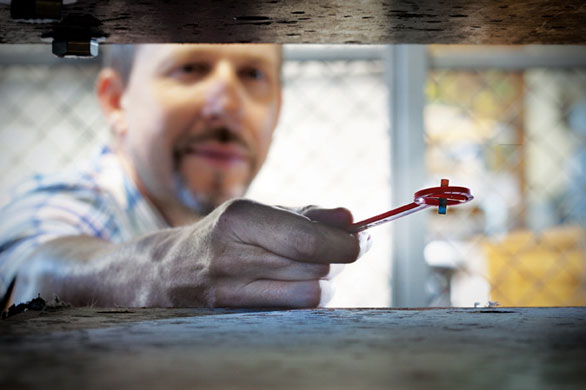Engineers flip for magnets

Photo: Bradley Plummer, SLAC
Forget pocket protectors: Flippy magnets are the low-tech tools that some high-tech engineers won’t be caught without.
The plastic hand-held stick topped with a rotating bar magnet the size of an Advil is a quick, easy way to find out if any of the magnets that steer particles through an accelerator is pointed in the wrong direction— a situation that can send particles flying off-course.
At SLAC’s Linac Coherent Light Source, for instance, a series of 210 electromagnets steer, compress, and focus a beam of electrons that is used to generate powerful pulses of X-ray laser light. The electron beam can’t deviate more than 10 microns as it passes through the magnets, so it’s important to get the magnetic fields aligned just right.
Unlike the magnets you have on your fridge, an electromagnet works only when turned on. Its north and south poles are determined by the direction a current flows through a coil to create the magnetic field. Reverse the flow of current and the magnet’s poles reverse. So in a special lab, engineers turned on each magnet, carefully measured its magnetic field and marked down how its two power cables should be hooked up to get current flowing in the right direction.
But then the magnets are transported from the measurement lab to the LCLS tunnel; and once there, the power cables, which are hundreds of feet long, may get hooked up the wrong way. To double-check the connections, an engineer walks the tunnel with a flippy magnet. It flips blue for north or red for south.
"It’s a nice, quick way of checking the magnets are the right polarity," says Scott Anderson, a SLAC magnet measurements engineer. The magnets-on-sticks can often be found lying around common areas. But lucky are the engineers who get their own. "Not everyone has a flippy magnet," Anderson says.
Marissa Cevallos
Click here to download the pdf version of this article.






